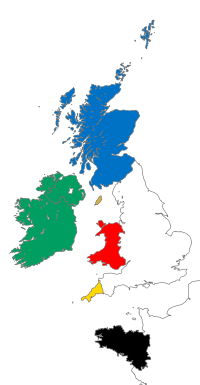Nantes
|
Nantes |
||
|
Motto: Latin: Favet Neptunus eunti |
||
| St. Peter & Paul's Cathedral, Nantes | ||
|
 |
|
| Traditional flag | Coat of arms | |
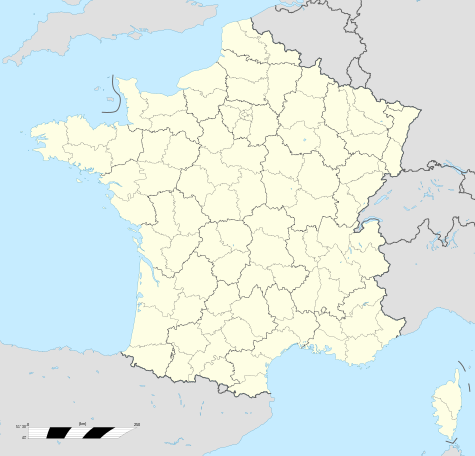 Nantes
|
||
| Administration | ||
|---|---|---|
| Country | France | |
| Region | Pays de la Loire | |
| Department | Loire-Atlantique | |
| Arrondissement | Nantes | |
| Canton | chief town of 11 cantons | |
| Intercommunality | Nantes Métropole | |
| Mayor | Jean-Marc Ayrault (PS) (2008–2014) |
|
| Statistics | ||
| Land area1 | 65.19 km2 (25.17 sq mi) | |
| Population2 | 283,025 (2007 census) | |
| - Ranking | 6th in France | |
| - Density | 4,342 /km2 (11,250 /sq mi) | |
| Urban area | 523.6 km2 (202.2 sq mi) (2008) | |
| - Population | 580,502 (2007) | |
| Metro area | 2,242.6 km2 (865.9 sq mi) (1999) | |
| - Population | 804,000 (2008) | |
| Time zone | CET (GMT +1) | |
| INSEE/Postal code | 44109/ 44000, 44100, 44200 and 44300 | |
| Dialling code | 02 | |
| Website | www.nantes.fr | |
| 1 French Land Register data, which excludes lakes, ponds, glaciers > 1 km² (0.386 sq mi or 247 acres) and river estuaries. | ||
| 2 Population sans doubles comptes: residents of multiple communes (e.g., students and military personnel) only counted once. | ||
Nantes (Breton: Naoned, Gallo: Naunnt) is a city in western France, located on the Loire River, 50 km (31 mi) from the Atlantic coast.[1] The city is the 6th largest in France, while its metropolitan area ranks 8th with over 800,000 inhabitants.[2]
Nantes is the capital city of the Pays de la Loire region and Loire-Atlantique département. It is also the major city of the historic province of Brittany, and culturally remains strongly identified with it.[3]
In 2004, the Time magazine described Nantes as "the most liveable city in Europe".[4]
Contents |
Etymology
The name Nantes, pronounced [nɑ̃t] in French, derives from that of its pre-Roman-era inhabitants, the Gaulish tribe known as the Namnetes, who founded a town there around 70 BC. The city was called Portus Namnetus during the Roman occupation that began in 56 BC. The inhabitants of Nantes are known in French as Nantais ([nɑ̃tɛ]).
Nantes' most common nickname is the Venice of the West (French: La Venise de l'Ouest, Breton: Venezia ar C'hornôg),[5] a name owing to its position on the river delta of the Loire, the Erdre, and the Sèvre (whose tributaries were infilled in the early 20th century).[6]
History
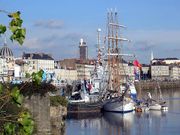
After having been occupied by the Gauls and the Romans, Nantes was Christianised in the 3rd century AD. The city was successively invaded by the Saxons (around 285), the Franks (around 500), the Britons (in the 6th and 7th centuries) and the Normans, who laid waste to it in 843: "The city of Nantes remained for many years deserted, devastated and overgrown with briars and thorns." The Chronicle of Nantes continues until the year 946, telling that Alain Barbe-Torte, grandson of Alan the Great, the last king of Brittany who was expelled by the Norse, drove them out and founded the Duchy of Brittany.[7][8]
When the Duchy of Brittany was annexed by the kingdom of France in 1532, Nantes kept the Parliament of Brittany for a few years before it was moved to Rennes. In 1598, King Henry IV of France signed the Edict of Nantes here, which granted Protestants rights to their religion.
During the 18th century, prior to abolition of slavery, Nantes was the slave trade capital of France.[9] This kind of trade led Nantes to become the largest port in France and a wealthy city. When the French Revolution broke out, Nantes chose to be part of it, although the whole surrounding region soon degenerated into an open civil war against the new republic known as the War in the Vendée. On 29 June 1793 the town was the site of a Republican victory in this war. The Loire was the site of thousands of executions by drowning, including those using the method which came to be known as the Republican marriage, in which a man and a woman were stripped naked, tied together, and thrown into the river.[10]
In the 19th century, Nantes became an industrial city. The first public transport anywhere may have been the omnibus service initiated in Nantes in 1826. It was soon imitated in Paris, London and New York. The first railways were built in 1851 and many industries were created. In 1940, the city was occupied by German troops. In 1941, the murder of a German officer, Lt. Col. Fritz Hotz, caused the retaliatory execution of 48 civilians. The city was twice severely bombed by British forces, on 16 and 23 August 1943, before being liberated by the Americans in 1944.[11]
Until the 1970s, Nantes' harbour was located on the Île de Nantes, when it was moved to the very mouth of the Loire River, at Saint-Nazaire. In the subsequent 20 years, many service sector organisations moved into the area, but economic difficulties forced most of these to close. In 2001, a major redevelopment scheme was launched, the goal of which is to revitalise the island as the new city centre.[12]
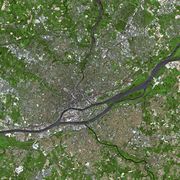
In 2003, the French weekly L'Express voted Nantes to be the "greenest city" in France, while in both 2003 and 2004 it was voted the "best place to live" by the weekly Le Point. In August 2004, Time designated Nantes as "the most livable city in all of Europe."[4][13]
Geography
Nantes is located on the banks of the Loire River, at the confluence of the Erdre and the Sèvre Nantaise, 55 km (35 mi) from the Atlantic Ocean. The city was built in a place where many branches of the Loire river created several islands, but most of those branches were filled in at the beginning of the 20th century (and the confluence with the Erdre river diverted and covered) due to the increasing car traffic.
It is notable that the city of Nantes is at the exact centre of Earth's land hemisphere.
Climate
About 50 kilometres away from the coast, Nantes has generally cool winters and mild summers, with rainfalls at least every week, which makes Nantes a temperate city, though winters can bring freezing temperatures and occasional hot spells in summer, especially during the month of July.[14]
Politics
Nantes is the préfecture (capital city) of both the Loire-Atlantique département and the Pays de la Loire région.
The Nantes metropolitan area (Nantes Métropole) is the intercommunal structure connecting the city of Nantes with nearby suburbs. It had a 1999 population of 554,478, 48.7% of which comprised the city of Nantes. The current mayor of Nantes is Jean-Marc Ayrault (PS), first elected in 1989 and now serving a sixth term, until 2014.[15]
Neighbourhoods
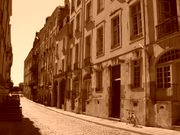
Since 1995, Nantes has been divided into 11 neighbourhoods, each resembling a historic city quarter. Each of these neighbourhoods is controlled by a Comité Consultatif (Consultative Committee), comprising directly elected officials and a team of municipal members, similar to a New England board of selectmen. These neighbourhoods are:
|
|
|
Nine of these neighbourhoods are situated on the right bank of the Loire, one is on the left bank, and one is on the Île de Nantes island.
Nantes and Brittany
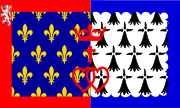
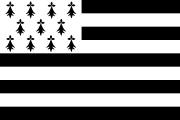
The city of Nantes, and the Loire-Atlantique département, were formerly part of the historic province of Brittany; Nantes was one of its traditional capitals, along with Rennes.[16]
Historically, the country around Nantes (French: Le Pays Nantais; Breton: Bro Naoned; Gallo: Paeï de Nàntt) was always seen as being part of Brittany. In 1207, the Dukes of Brittany made Nantes their home, building the Castle of the Dukes of Brittany on the banks of the Loire. Most of the dukes and duchesses were buried in either the cathedral or the nearby abbeys.
In 1789, the separation of the historical provinces of France resulted in Brittany being split in five; the lower of the five, Loire-Inférieure (today Loire-Atlantique) was where Nantes was situated. As such, Brittany as an administrative region did not exist during the 19th and early 20th centuries, although it did still exist culturally and informally.[17] When regional regroupments during the 20th century resulted in the reinstatement of the regions, Loire-Atlantique found itself split from the other four départements by the Vichy regime in 1941; a new région had been created centred on Nantes, the Pays de la Loire.
Much debate surrounding this move persists. Those against (sometimes called the Breton militants) maintain that the separation was made by a non-democratically elected government, and that Loire-Atlantique is culturally, historically and geographically united to Brittany; those in favour argue that any reunification would reopen a "quarrel of the capitals" between Nantes and Rennes, and that it would be fatal to the Pays de la Loire région.[18]
The issue of linguistics is also relevant; in Upper Brittany (locally called Bretagne Gallèse or Haute Bretagne) Romance languages especially the local Gallo, as well as French, have long had more influence than Breton. However, in many large cities, including Nantes and Saint-Brieuc, the Breton language has sometimes been spoken more widely than Gallo by the very urban and bourgeois population there (even though in Le Pays Nantais the opposite was true). In recent years, many bilingual plaques have appeared on tourist attractions in the city, with the help of the Ofis ar Brezhoneg (French: Office de la Langue Bretonne; English: Office of the Breton Language).
Most recently, on 15 May 2004, a hastily organized demonstration in Nantes calling for the reunification of Brittany attracted 6,000 participants, while in five surveys on the issue, between 62% and 75% of the population of Loire-Atlantique have come out in favour of reunification.[19]
In 2008, 1.4% of the children in Nantes attended the bilingual schools for primary education.[20]
Education
Colleges and universities
|
|
Transport
The first organized omnibus transit system within a city appears to have originated in Nantes in 1826.[21] The current network operated by Tan network includes three tramway lines, one bus rapid transit route (known as BusWay), dozens of bus routes, an express bus between Nantes Atlantique Airport, and the city centre (known as Tan Air), three navibuses lines and four suburban train lines (operated by SNCF and running on four intercity train lines within the city's limits). Longer distance travel throughout the Loire-Atlantique département is operated by Lila network, which runs interurban buses. The Tramway de Nantes originally began operation in 1879, but this first generation network closed in 1958. A new generation of tram lines opened in 1985, and the tram network is now the longest in France. The tram network, also part of the Tan network, shares a common ticketing system with buses and other modes within that network.[22]
Nantes railway station lies on a number of rail lines. Nantes is connected by TGV (high speed train) to Paris, Lyon, Marseille, Lille, and Strasbourg, with trains to Paris via the LGV Atlantique taking just over 2 hours. By Corail, Nantes is connected to Quimper, La Rochelle, Bordeaux, Lyon, and Toulouse. The regional trains and buses of the TER Pays de la Loire provide links to Saint-Nazaire, Angers, Le Mans, La Roche sur Yon, and many other regional cities.
Nantes was formerly a major commercial port, with port facilities on the River Loire in the city centre. Much of the commercial traffic has since migrated downstream, principally to the area around Saint-Nazaire, although the river remains navigable to ocean-going ships as far as Nantes. River cruises operate on both the Loire and its tributary the Erdre. The Tan network also includes three urban water bus routes on both rivers (known as Navibus).
Nantes Atlantique Airport, located 8 km to the south-west of the city centre, serves the city and surrounding areas. It is the biggest airport in western France, linking with several French and European cities, as well as Montreal in Canada and some northern Africa cities. It is currently planned that this airport will be replaced by the Aéroport du Grand Ouest, that will be situated 30 km to the north-west of Nantes in the commune of Notre-Dame-des-Landes. The €580 million project was approved in February 2008, with construction expected to start in 2012 and a opening date in 2015.[23]
Main sights
Castles, churches and mosques

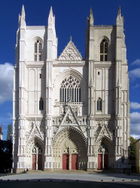
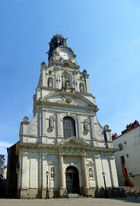
- Château des ducs de Bretagne (Castle of the Dukes of Brittany).
- Cathedral of Saints Peter and Paul.
- Église Notre-Dame de Bon-Port (Basilica of Saint-Louis).
- Église Saint-Nicolas (Basilica of Saint Nicolas, 1844).
- Église Sainte-Croix (Church of the Holy Cross).
Nantes has two mosques:
- Mosquée Arrahma
- Mosquée des Turcs (photo)
A third (Mosquée Assalam) is under construction.
Museums
- Musée d'histoire de Nantes (Nantes History Museum); located inside the Castle of the Dukes of Brittany.
- Musée des Beaux-Arts de Nantes (Fine Arts Museum of Nantes).
- Muséum d'histoire naturelle (Natural History museum).
- Musée Thomas Dobrée (Thomas Dobrée archaeological museum).
- Musée Jules Verne (Jules Verne museum).
- Musée naval Maillé-Brézé (naval museum).
- The Pays de la Loire regional contemporary art collection.
- The Planetarium.
Historical places
- The Isle of Nantes; a former shipyard turned into a leisure and cultural site, including the Machines of the Isle of Nantes permanent exhibition.
- Passage Pommeraye; 19th century galleria with shopping.
- Brasserie La Cigale; described by Jean-Louis Trintignant as "perhaps the most beautiful brasserie in the world."[24]
- Place du Commerce; the city's main square.
- Place Royale; a historic square located in the heart of the city, recently renewed.
- Place Graslin; a historic place featuring the Theatre of Nantes and famous brasserie La Cigale.
- Crebillon street and Orleans street lined with luxury boutiques linked by the Place Royale.
- The new Palais de Justice (court house); built in 2000 and designed by Jean Nouvel.
- La Tour LU (the LU Tower); a tower standing the entrance of the former Lefèvre-Utile biscuit factory.
- Beaujoire Stadium; Nantes' largest sports stadium, home of FC Nantes Atlantique football club.
- Le Marché de Talensac (Talensac Market); the main and historical public market.
Gardens and parks
- Jardin des plantes de Nantes
Leisure
Nantes has several cinemas including:
- Gaumont Nantes; centrally located at Place du Commerce in the heart of the city.
- Concorde; a historic cinema in central Nantes.
- Pathé Atlantis; Nantes' biggest cinema, also located in the borough of Saint-Herblain, in the Atlantis commercial zone.
Concert halls
|
|
Culture
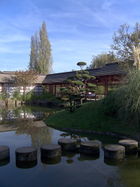
Cultural events
Nantes hosts quite a few cultural events of note, of which these are just a few:
- Estuaire, a contemporary art exhibition that takes place every two years between Nantes and Saint-Nazaire (along the Loire estuary).
- Les Rendez-vous de l'Erdre, a jazz festival centered around the Erdre river.
- Les rencontres du fleuve, a festival centered around ships and the river.
- Le Festival Eidos du film d'environnement et de développement durable, a cinema festival themed around the environment and sustainability.
- The Festival des trois continents, dedicated to African, Asian and South American cinema.
- La Folle Journée, a classical music festival,
- Les Utopiales, international science fiction convention,
- The Festival Voisinages, various theatre performances (Théâtre du Grand T, Théâtre universitaire de Nantes, salle Onyx de Saint-Herblain).
Sport
The local football team is FC Nantes. During the 2007 Rugby World Cup in France, Nantes hosted a number of matches including England against Samoa and Wales against Fiji.
Music
There are quite a few bands from Nantes who play different genres but are not well known outside of France.
The Celtic band Tri Yann was originally known as Tri Yann an Naoned (the three Johns from Nantes).
The DJ group C2C, champion of the Disco Mix Club World Team DJ Championship four years in a row (2003–2006)[25] is native of Nantes.
The American band Beirut, following with their European influences, have a song on their second album The Flying Club Cup titled 'Nantes'.
To see a list of Bands from Nantes, see fr:Rock à Nantes (French).
Media
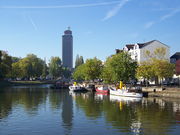
Local television channels
|
|
|
Radio stations
- Nova @ 87.8
- Rires Et Chansons @ 88.4
- MFM Sud Loire @ 88.8
- Alouette @ 89.5
- RFM @ 90.1
- France-Inter @ 90.6
- JET FM @ 91.2
- Radio Prun' @ 92.0
- Virgin Radio @ 94.7
- FIP Nantes @ 95.7
- Hit West @ 100.9
- Radio France Bleu Loire-Ocean @ 101.8
- NRJ @ 102.4
- Fidélité @ 103.8
- RTL @ 104.3
- Europe 1 @ 104.7
- France Infos @ 105.5
- Cherie FM @ 106.2
- Radio Classique @ 106.7
- BFM @ 107.2
Local newspapers
Newspapers for sale:
|
|
Free newspapers:
|
|
Famous Nantais
- Anne of Brittany, Duchess of Brittany and Queen of France (the only woman to have married two kings of France, Charles VIII and Louis XII)
- Louis-Albert Bourgault-Ducoudray, composer and professor (Prix de Rome laureate)
- Claire Bretécher, cartoonist (creator of "Les Bidochons")
- Aristide Briand, French statesman (1926 Nobel Peace Prize laureate)
- Claude Cahun (born Lucy Schwob), photographer and author
- Pierre Cambronne, general (commander of the Old Guard at Waterloo)
- Jacques Cassard, corsair
- Jeanne Cherhal, singer and songwriter
- Jacques Demy, movie director
- Jean Graton, cartoonist (creator of "Michel Vaillant")
- Linda Hardy, actress and top model (Miss France 1992)
- Paul Ladmirault, composer
- Julien de Lallande Poydras, New Orleans member of the United States House of Representatives
- Christophe-Léon-Louis Juchault de Lamoricière, general and politician (commander of the Papal army)
- Suzanne Malherbe (aka Marcel Moore), illustrator and designer
- Patrice Martin, water skier(12-time world champion)
- Anna Mouglalis, actress
- Benoit Regent, actor
- Claude Sérillon, journalist
- Éric Tabarly, sailor
- Jérémy Toulalan, footballer
- Jules Verne, author
- Pierre Waldeck-Rousseau, politician
International relations
Twin towns
Nantes has town twinning and cooperation agreements with:
|
|
|
Friendship relations
The city has friendship relations with:
 Guinea, since 1992.
Guinea, since 1992. St. Martinville, Louisiana, U.S., since 1993.
St. Martinville, Louisiana, U.S., since 1993. Jericho, West Bank, since 2001.
Jericho, West Bank, since 2001. Desdunes and Petionville, Haiti, since 2005.
Desdunes and Petionville, Haiti, since 2005. Nantes, Quebec, Canada, since 2009.
Nantes, Quebec, Canada, since 2009.
References
Notes
- ↑ Nantes Hutchinson Encyclopedia. Retrieved on 14 August 2007.
- ↑ Population des villes de France au dernier recensement PopulationData.net. Retrieved on 14 August 2007.
- ↑ A New Luster in the Ancient Heart of Brittany The New York Times, 5 August 2007. Retrieved on 7 August 2007.
- ↑ 4.0 4.1 The Last Best Place In Europe Time Europe, 22 August 2004. Retrieved on 4 August 2007.
- ↑ The Venice of the West RugbyWorldCup.com. Retrieved on 07-12-07.
- ↑ Blue Nantes FranceGuide.com. Retrieved on 07-12-07.
- ↑ David C Douglas, ed. English Historical Documents (Routledge, 1979) "Secular Narrative Sources" pp 345f.
- ↑ Chronicle of Nantes English Historical Documents. Dorthy Whitelock, David Charles Douglas. Routledge, 1996 ISBN 0415143667 Retrieved on 30-10-07.
- ↑ Leslie Choquette, Frenchmen into peasants: modernity and tradition in the peopling of French Canada (1997), p. 56
- ↑ Ruth Scurr, Fatal Purity: Robespierre And the French Revolution (2006) p. 305
- ↑ "tourisme/culture - France - Nantes - histoire page". reception. 1941-10-22. http://www.reception.com/US/nantes/histoire.htm. Retrieved 2009-07-08.
- ↑ Revit Metropolitan Development
- ↑ A recognized quality of life Business in Western France. Retrieved on 4 August 2007.
- ↑ Climate information for Nantes Retrieved on 08-09-07.
- ↑ "Ville de Nantes: Jean-Marc Ayrault". Nantes.fr. http://www.nantes.fr/mairie/municipalite/delegations-d-elus/jean-marc-ayrault.html. Retrieved 2009-07-08.
- ↑ Presentation of Nantes CRWFlags.com. Published on 28-04-07. Retrieved on 07-12-07.
- ↑ "Reviews of The Life and Science of Léon Foucault. The Man who Proved the Earth Rotates.". .phys.canterbury.ac.nz. http://www2.phys.canterbury.ac.nz/~wjt23/Horn.html. Retrieved 2009-07-08.
- ↑ Loire-Atlantique guide
- ↑ "Does the Breton language have a future?". Breizh.net. May 2004. http://www.breizh.net/icdbl/saozg/endangered.htm#Does%20the%20Breton%20language%20have%20a%20future. Retrieved 2007-08-07.
- ↑ (French) Ofis ar Brezhoneg: Enseignement bilingue
- ↑ Rodrigue, Dr. Jean-Paul. "Omnibus, Paris Late 19th century". Hofstra University. http://people.hofstra.edu/geotrans/eng/ch6en/conc6en/omni.html. Retrieved 2007-08-09.
- ↑ Wansbeek, C.J. (January 2001). "Nantes expansion - City tram now a mature network". Tramways & Urban Transit (Ian Allan Ltd / Light Rail Transit Association). http://www.lrta.info/articles/art0101.html. Retrieved 2007-08-09.
- ↑ "New Notre Dame des Landes Airport, Nantes, France". airport-technology.com. http://www.airport-technology.com/projects/newnantes/. Retrieved 2008-07-24.
- ↑ Birkin, Jane (2003-02-09). "My favourite table". The Observer. http://shopping.guardian.co.uk/food/story/0,,889437,00.html. Retrieved 2008-03-21.
- ↑ "DMC website". Dmcworld.com. http://www.dmcworld.com/championships/worldchampions/. Retrieved 2010-04-13.
- ↑ "Tbilisi Municipal Portal - Sister Cities". © 2009 - Tbilisi City Hall. http://www.tbilisi.gov.ge/index.php?lang_id=ENG&sec_id=4571. Retrieved 2009-06-16.
- ↑ "Sister Cities Home Page". http://www.durban.gov.za/durban/government/igr/idr/sister. eThekwini Online: The Official Site of the City of Durban
External links
- Official website of the city of Nantes (French)
- Nantes Tourist Office Official Website (English)
- (TAN) Nantes public transport official website (French)
- Nantes Atlantique International Airport website (English)
- Official website of Nantes' Castle (English)
- Rugby World Cup 2007 in Nantes (French)
- A Photo Gallery of Nantes
|
||||||||
|
|||||||||||||||||||||||||||
|
|||||

